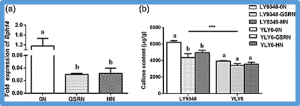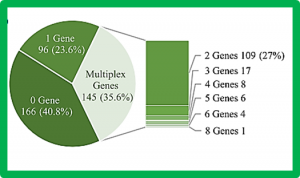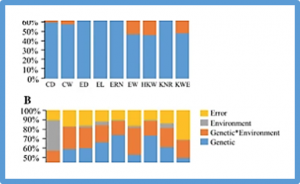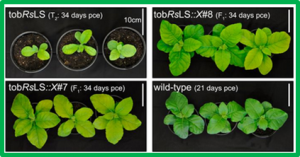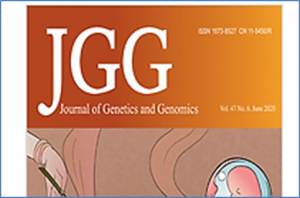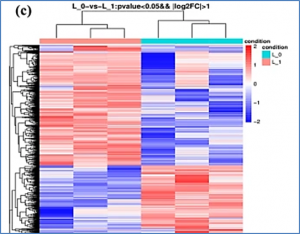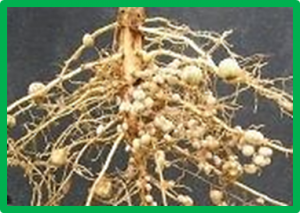Brown rice planthopper (BPH) is a devastating rice pest in Asia. Bph14 is the first cloned BPH-resistance gene in rice, inducing callose deposition while impeding BPH feeding. Nitrogen application affects plant growth and resistance. However, there is little evidence on the influence of nitrogen on the callose content or regulation of rice BPH resistance
The potential risks of Bt rice on non-target arthropods (NTAs) should be evaluated and defined before commercial production. Recently, effects of Bt rice on NTAs under abiotic and biotic stress conditions attracted much attention. Here we reported the effects of Bt rice T1C-19 (Cry1C rice) on the non-target herbivore, Nilaparvata lugens (rice brown planthopper, BPH) with or without RDV (rice dwarf virus) infection conditions.
The output of genetic mutant screenings in soya bean [Glycine max (L.) Merr.] has been limited by its paleopolypoid genome. CRISPR-Cas9 can generate multiplex mutants in crops with complex genomes. Nevertheless, the transformation efficiency of soya bean remains low and, hence, remains the major obstacle in the application of CRISPR-Cas9 as a mutant screening tool. Here, we report a pooled CRISPR-Cas9
Understanding the genetic basis of yield-related traits contributes to the improvement of grain yield in maize. This study used an inter-mated B73 × Mo17 (IBM) Syn10 doubled-haploid (DH) population and an association panel to identify the genetic loci responsible for nine yield-related traits in maize. Using quantitative trait loci (QTL) mapping, 100 QTL influencing these traits were detected across different environments in the IBM Syn10 DH population,
Sulfonylurea herbicides, which inhibit acetohydroxyacid synthase (AHAS), have become the most widely used herbicides worldwide. However, weed control in rapeseed crop production remains challenging in China due to the shortage of available herbicide-resistant cultivars. In this study, we developed a rapeseed line (PN19) with sulfonylurea herbicide resistance through seed mutagenesis.
Plant photosynthesis and growth are often limited by the activity of the CO2-fixing enzyme Rubisco. The broad kinetic diversity of Rubisco in nature is accompanied by differences in the composition and compatibility of the ancillary proteins needed for its folding, assembly, and metabolic regulation. Variations in the protein folding needs of catalytically efficient red algae Rubisco prevent their production in plants.
The TaQ alleles as one of the AP2-like transcription factors in common wheat (Triticum aestivum) play an important role in the evolution of the spike characteristics from wild and domesticated emmer to modern wheat cultivars. Its loss-of-function mutant not only changed threshability and spike architecture, but also affected plant height, flowering time, and floret structure. However, the comprehensive functions of TaAQ and TaDq genes in wheat have not been fully elucidated yet.
We conducted a hydroponic experiment using a complete nutrient solution (N1) and a nutrient solution without nitrogen (N0). Wheat plants under nitrogen-deficient conditions (NDC) showed decreased crop height, leaf area, root volume, photosynthetic rate, crop weight, and increased root length, root surface area, root/shoot ratio. It indicates that nitrogen deficiency altered the phenotype of wheat plants.
Since 1999, various forward- and reverse-genetic approaches have uncovered nearly 200 genes required for symbiotic nitrogen fixation (SNF) in legumes. These discoveries advanced our understanding of the evolution of SNF in plants and its relationship to other beneficial endosymbioses, signaling between plants and microbes, the control of microbial infection of plant cells, the control of plant cell division leading to nodule development,
Salinity has drastic effects on plant growth and productivity and is one of the major factors responsible for crop yield losses throughout the agricultural soils of the world. The mechanisms of salinity tolerance in plants are regulated by a set of inherent multigenes and prevalent environmental factors, which bring about a myriad of metabolic changes in each plant part. The stress-induced metabolic changes in the rice plant have been intensively studied


 Curently online :
Curently online :
 Total visitors :
Total visitors :
